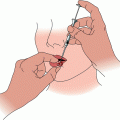TX
Primary tumor cannot be assessed
T0
No evidence of primary tumor
Tis
Carcinoma in situ
T1
Tumor ≤2 cm in greatest dimension with <2 high-risk featuresb
T2
Tumor >2 cm in greatest dimension or
Tumor any size with ≥2 high-risk featuresb
T3
Tumor with invasion of maxilla, mandible, orbit, or temporal bone
T4
Tumor with invasion of skeleton (axial or appendicular) or perineural invasion of skull base
Table 2
High-risk features for primary tumor (T) staging for cutaneous non-eyelid carcinoma
Depth/invasion | >2 mm thickness (Breslow thickness) |
Clark level ≥IV | |
Perineural invasion | |
Anatomic location | Primary site ear |
Primary site non-hair-bearing lip | |
Differentiation | Poorly differentiated or undifferentiated |
Table 3
Regional lymph nodes (N) for cutaneous carcinoma
NX | Regional lymph nodes cannot be assessed |
N0 | No regional lymph node metastases |
N1 | Metastasis in a single ipsilateral lymph node, ≤3 cm in greatest dimension |
N2 | Metastasis in a single ipsilateral lymph node, >3 cm but ≤6 cm in greatest dimension; or in multiple ipsilateral lymph nodes, ≤6 cm in greatest dimension; or in bilateral or contralateral lymph nodes, ≤6 cm in greatest dimension |
N2a | Metastasis in a single ipsilateral lymph node, >3 cm but ≤6 cm in greatest dimension |
N2b | Metastases in multiple ipsilateral lymph nodes, ≤6 cm in greatest dimension |
N2c | Metastases in bilateral or contralateral lymph nodes, ≤6 cm in greatest dimension |
N3 | Metastasis in a lymph node, >6 cm in greatest dimension |
Table 4
Anatomic stage/prognostic groups for cutaneous carcinoma
Stage | T | N | M |
|---|---|---|---|
0 | Tis | N0 | M0 |
I | T1 | N0 | M0 |
II | T2 | N0 | M0 |
III | T3 | N0 | M0 |
T1 | N1 | M0 | |
T2 | N1 | M0 | |
T3 | N1 | M0 | |
IV | T1 | N2 | M0 |
T2 | N2 | M0 | |
T3 | N2 | M0 | |
Any T | N3 | M0 | |
T4 | Any N | M0 | |
Any T | Any N | M1 |
Table 5
Primary tumor (T) for eyelid carcinoma
TX | Primary tumor cannot be assessed |
T0 | No evidence of primary tumor |
Tis | Carcinoma in situ |
TX | Primary tumor cannot be assessed |
T1 | Tumor ≤5 mm in greatest dimension |
Not invading the tarsal plate or eyelid margin | |
T2a | Tumor >5 mm but not >10 mm in greatest dimension |
Or, any tumor that invades the tarsal plate or eyelid margin | |
T2b | Tumor >10 mm but not >20 mm in greatest dimension |
Or, involves full thickness eyelid | |
T3a | Tumor >20 mm in greatest dimension |
Or, any tumor that invades adjacent ocular or orbital structures | |
Any T with perineural tumor invasion | |
T3b | Complete tumor resection requires enucleation, exenteration, or bone resection |
T4 | Tumor is not resectable because of extensive invasion of ocular, orbital, craniofacial structures, or brain |
Table 6
Regional lymph nodes (N) for eyelid carcinoma
NX | Regional lymph nodes cannot be assessed |
cN0 | No regional lymph node metastasis based upon clinical evaluation or imaging |
pN0 | No regional lymph node metastasis based upon lymph node biopsy |
N1 | Regional lymph node metastasis |
Table 7
Anatomic stage/prognostic groups for eyelid carcinoma
Stage 0 | Tis | N0 | M0 |
Stage IA | T1 | N0 | M0 |
Stage IB | T2a | N0 | M0 |
Stage IC | T2b | N0 | M0 |
Stage II | T3a | N0 | M0 |
Stage IIIA | T3b | N0 | M0 |
Stage IIIB | Any T | N1 | M0 |
Stage IIIC | T4 | Any N | M0 |
Stage IV | Any T | Any N | M1 |
In general, radial size for both SCC and BCC is thought to mirror biologic behavior. Overall staging is based on radial size (stage I <2 cm and stage II >2 cm). As the carcinomas extend vertically, with invasion into deeper tissue such as bone and beyond to lymph nodes, they receive a higher overall stage (III–IV). Based solely on T (tumor) component of the TNM classification system, invasion into the maxilla, mandible, orbit, or temporal bone automatically receives an overall stage III (T3 N0 M0) and direct or perineural invasion into the skull base or axial skeleton receives an overall stage IV (T4 N0 M0). Similarly, based solely on N (nodal involvement) of the TNM classification system, involvement of a single ipsilateral node ≤3 cm in size receives an overall stage III and involvement of nodes ≥3 cm in size or multiple nodes receives an overall stage IV. Metastasis is categorized as either M0 (no metastasis) or M1 (distant metastasis, which if present, is assigned an overall stage IV) for SCC and BCC.
Staging for Squamous Cell Carcinoma Treated by Dermatologists Utilizing Radiotherapy
As mentioned previously, AJCC staging primarily applies to SCC as BCC has a different biological behavior and is limited mainly to local destruction with very little chance of distant metastasis (see Chaps. 7, 8 and 9




Stay updated, free articles. Join our Telegram channel

Full access? Get Clinical Tree





